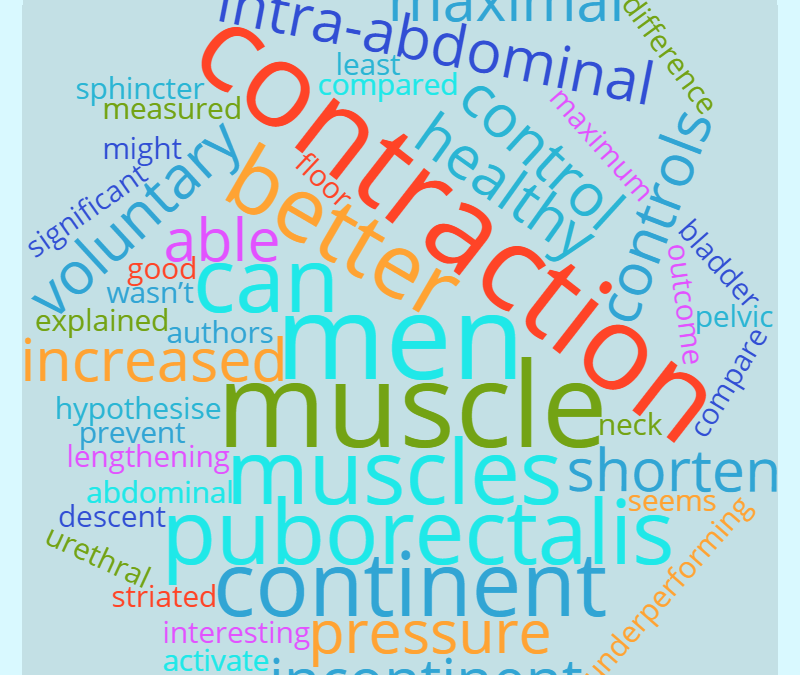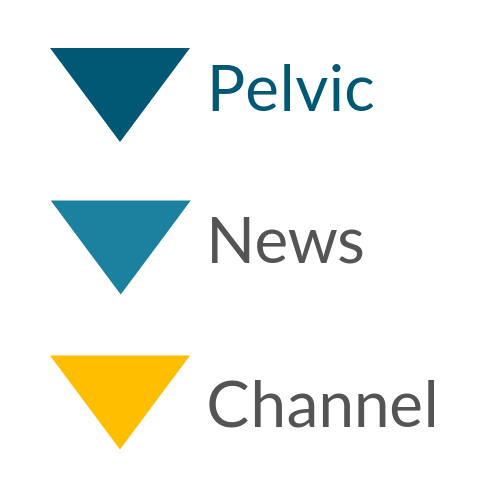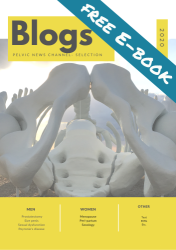Urinary incontinence is a common complaint after radical prostatectomy. When the prostate is removed so is a lot of the urethral smooth muscle. The urethral smooth muscle helps to compress the urethra. Therefor the striated muscles gain in importance after radical prostatectomy for compressing the urethra.
There are three muscles involved:
- Striated urethral sphincter
- Bulbocavernosus
- Puborectalis
A way to investigate the function of these three muscles is by transperineal ultrasound.
Pelvic physiotherapy is often given in case of incontinence. However, the results are mixed. Some research show a beneficiary results and others don’t. If we have more knowledge on what pelvic floor function is needed to gain continence, this might help us improve our treatment strategy.
The research I am going to discuss today is all about this important question. It investigates the difference between continent and incontinent men post prostatectomy and an age-matched control group.
Some tables in this blog are due to their size best to read on a tablet or PC!
The study has the following aims:
- To see if there is a difference in striated pelvic floor muscle contraction between the groups
- To see if there is a difference in amplitude of contraction between the groups
Group details (table 1)
Table 1_Groups
| Group | Incontinent post-prostatectomy (PPI) | Continent post-prostatectomy (PPC) | Control group (CC) |
|---|---|---|---|
| N= | 20 | 23 | 20 |
| Inclusion criteria | >4 on International Continence Society Male Short Form (ICS-male SF) | Continent post-prostatectomy | |
| Exclusion criteria | - pre surgery urinary incontinence - pelvic surgery - pelvic radiation | - urinary incontinence - prostate cancer - prior LUTS - pelvic surgery |
|
| No difference in age, height, weight, and PPI and PPC groups time after prostatectomy | |||
The ultrasound transducer was placed in the sagittal plane on the perineum. The urethra, anorectal junction, penile bulb, and pubic symphysis (landmarks) were visible and measured in that way.
The participants sat semireclined and were asked to (task, table 2):
Table 2: tasks
| 1 | Shorten the penis | Maximal voluntary contraction (MVC) - 30 seconds |
| 2 | Shorten the penis a 3 on a 10 point scale | Submaximal contraction |
| 3 | Bear down as if you are emptying your bowel or pass a wind, 8 on a 10 point scale | |
| 4 | Cough (provoked with medication) | Reaction of pelvic floor |
Changes were measured of the different landmarks during the tasks asked (please read the full article if you want to know the exact way how this was measured and how statistical analysis was performed).
Results(table 3):
Table 3: Maximum voluntary contraction
| Task | Displacement of | Significant difference | No difference |
|---|---|---|---|
| maximum voluntary contraction | Mid-urethra/ Striated urethral sphincter | PPC > PPI | PPC = CC |
| Bulb of penis/ Bulbocavernosus | PPC > PPI | PPC = CC | |
| Anorectal junction/ puborectalis muscle | PPC > PPI PPI < CC | ||
| Observation of descent | |||
| Urethra-vesical junction (descent=lenghtening of puborectalis muscle) | 10/20 PPI (50%) | 2/23 PPC (9%) 0/20 CC (0%) |
|
| Submaximal contraction | Mid-urethra/ Striated urethral sphincter | PPC > PPI PPI < CC | PPC = CC |
| Bulb of penis/ Bulbocavernosus | PPC > PPI PPI < CC | PPC = CC | |
| Anorectal junction/ puborectalis muscle | PPC > PPI PPI < CC | PPC = CC | |
| Urethra-vesical junction (descent=lenghtening of puborectalis muscle) | PPI < CC NO DESCENT | PPC = PPI PPC = CC NO DESCENT |
|
| Bear down | Mid-urethra/ Striated urethral sphincter | All groups | |
| Bulb of penis/ Bulbocavernosus | All groups | ||
| Anorectal junction/ puborectalis muscle | All groups | ||
| Urethra-vesical junction (descent=lenghtening of puborectalis muscle) | CC > PPI | PPC = CC | |
| Evoked coughing (pelvic floor reaction=shortening) | Mid-urethra/ Striated urethral sphincter | PPC > PPI PPI < CC | PPC = CC |
| Bulb of penis/ Bulbocavernosus | PPC > PPI PPC > CC | ||
| lengthening | Urethra-vesical junction (descent=lenghtening of puborectalis muscle) | PPI < CC PPC < CC | PPC = PPI |
| Urethra-vesical junction (descent=lenghtening of puborectalis muscle) | PPC < PPI PPC < CC | ||
| PPC=Continent post-prostatectomy, PPI= Incontinent post-prostatectomy, CC= Control group, > = greater than, = = equal, < = smaller than | |||
How to differentiate pelvic floor control between the continent and incontinent group
The receiver operating characteristics (ROC) showed specificity of 85% and sensitivity of 78%, when the striated urethral sphincter had a displacement of ≥4.1 mm and the uretha-vesical junction one of ≥2.4 mm.
These results show that continent men after prostatectomy;
- Can shorten their muscles (striated urethral sphincter, bulbocavernosus muscle, puborectalis muscle) better than incontinent men during maximal and submaximal contraction.
- Can prevent bladder neck descent better than healthy controls
- Are able to shorten the bulbocavernosus muscle better than the healthy controls
If you compare the continent and control men there is no significant difference during maximal and submaximal voluntary contraction. It seems that the continent men are able to activate the pelvic floor muscles at least as good as the control men.
*Another interesting outcome is that during maximum voluntary contraction 50% of the incontinent men had a lengthening of the puborectalis muscle compared to 9% of the continent men. The authors hypothesise that this might be explained by an increased intra-abdominal pressure (this wasn’t measured). The intra-abdominal pressure can be increased because of abdominal muscle contraction or underperforming puborectalis muscles.
What do these results mean for the pelvic physiotherapist?
- Continent men after a prostatectomy can shorten the striated urethral sphincter 4.1mm and the puborectalis muscle 2.4mm. So if we use perineal ultrasound we can use these numbers.
- We should check if the abdominal muscles are activated during maximum pelvic floor muscle contraction. If the abdominal muscles are contracted we can teach our patients to relax them at that moment. So instruct a proper pelvic floor muscle contraction.
In this research it wasn’t recorded if the men had had pelvic floor muscle exercises. So it is not known if the muscle function was due to a trainings program.
In this blog I haven’t discussed all outcomes and it I want to recommend studying the full original article. It is full of very valuable information on for instance the relation between anatomy and continence as well.
Reference:
Comparison of dynamic features of pelvic floor muscle contraction between men with and without incontinence after prostatectomy and men with no history of prostate cancer. Stafford RE, Coughlin G, Hodges PW, Neurourol Urodyn 2019 nov 13. doi: 10.1002/nau.24213. [Epub ahead of print]









Recent Comments